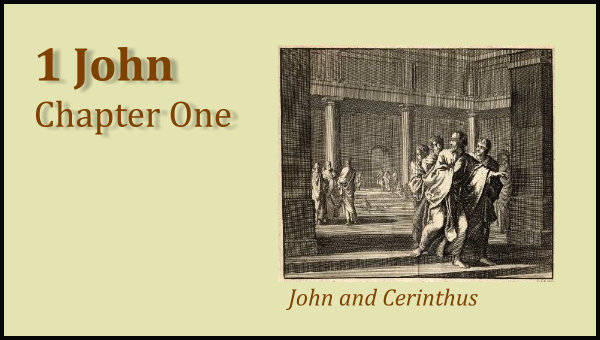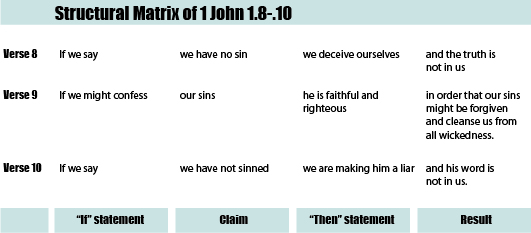By Tyson Thorne

The book of 1 John was written by the apostle John to Christian readers so that their life might change to reflect the nature of the God they serve. It appears that He is writing the letter to clarify the true Christian faith, and to combat some distortions of meaning entering the faith from Cerinthus’ followers. Evidence for this lies in verses 1-7, which is a testimony to the true Christ and His teachings. In verse eight we see a shift from this testimony to a hypothetical situation. Examine the structural layout of the verses below.
Above is the passage of I John 1.8-.10 as translated most literally from the Greek. By putting it in a structural matrix I hope to make a number of things obvious. For instance, notice how each of these three verses begins with the possibility of us (the reader) making some sort of “If” statement (If we say, or, if we might confess). Second, notice how the second phrase of each verse is a claim about sin (we have no sin, admit we have sins, we have not sinned). This is followed by a “Then statement completing the earlier “If” and ends with a result.
It is plain to see that these three verses have much in common, both structurally, as well as in content. More importantly, they disclose important truths about humanity.
If John is writing to combat a heretical group, then these hypothetical statements are probably ways to defend truth from their error. Hence, the heresy probably consisted of the belief that we have not sinned, nor are we with sin, and so there is no need of repentance. This is a good description of the teachings of Cerinthus.
John addresses the concerns of the pre-Gnostic heresy of Cerinthus, throughout the book of 1 John. In verse one John states that Jesus could not be a phantom, as he himself had seen and touched Jesus. One does not touch a phantom or spirit. He was a physical being and, verse three, also the holy Son of God. This directly combats the notion that God merely “came upon” Jesus in a special way, and that the human body shares an evil with all physical matter.
He then once again lays down definitions crucial to understanding the gospel. The words John defines had been corrupted by the cultists to mean something different, and now John reclaims those words in truth. Those who pit themselves against the Word of God continue to use this tactic. Last week the Supreme Court attempted to redefine marriage as a union between two people, regardless of their gender. However, neither they, nor any human, invented marriage so no human has the authority to redefine it. God invented marriage and defined it as a union between a man and a woman. So call it what you will, but any union between two people of the same gender isn’t marriage. The Supreme Court may as well have redefined the color blue to mean “green”.
There can be no mistake about what a Christian life is to look like, or where its power comes from. God is our source of power. Our life is to look very different as a result. While no longer a formal religion, elements of Cerinthus’ beliefs still exist today. The belief that matter is evil; a desire for the “super-spiritual”; and a tendency toward loose morals. How do we counter these trends among modern Christians?
|
|